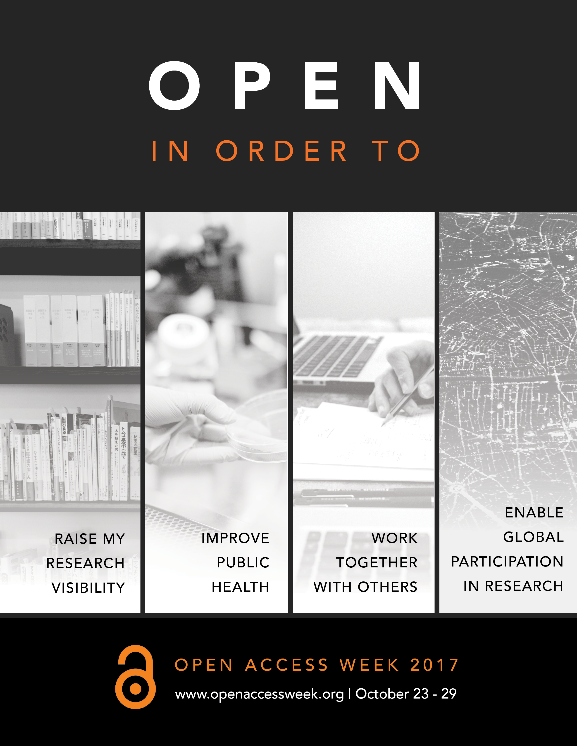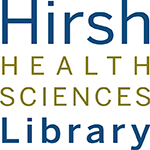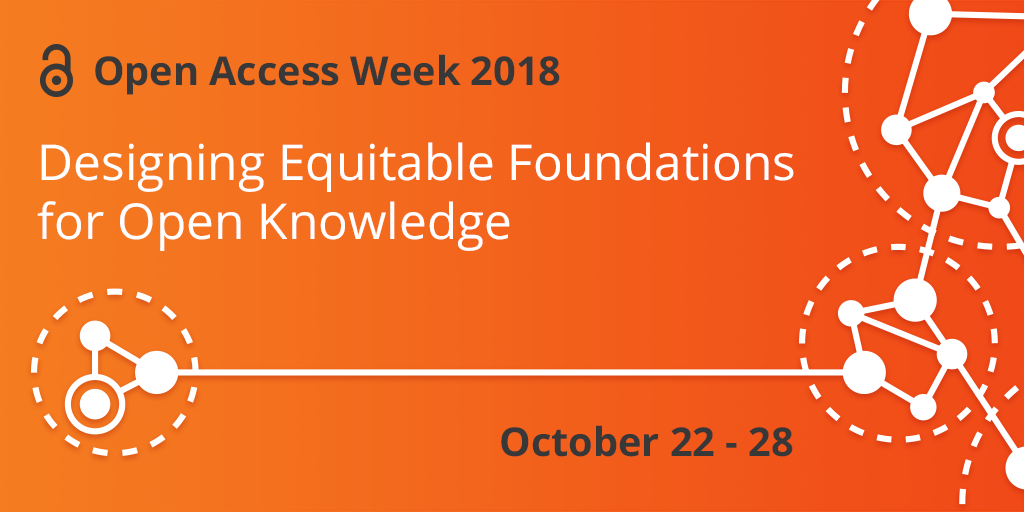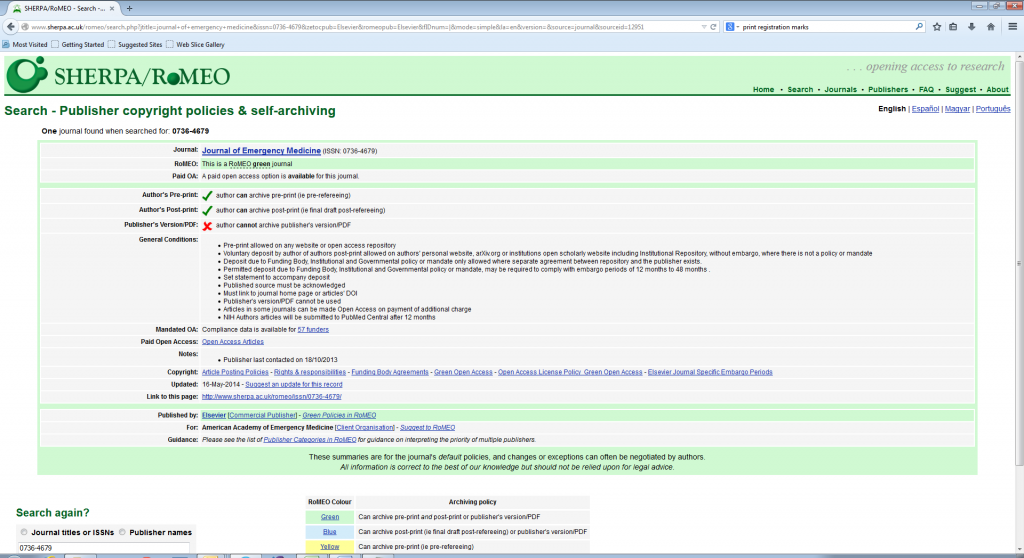You’ve probably heard the term open access – maybe it’s the reason you were able to get the full text of that article you needed? Maybe it’s the reason so many people read your latest article?
Open access (OA) is about making research literature freely available on the Internet with few copyright or license restrictions. In honor of Open Access Week (happening right now!), here are the top 10 reasons to publish OA…
10. Improve discoverability
Open articles commonly show up more places than just the publisher’s website, for example, in subject repositories or ResearchGate or the Tufts Digital Library, and therefore can more readily be found by search engines and through web surfing, not just through traditional articles databases, like PubMed or Web of Science. In addition, search engines can more readily crawl the entire full text of open articles, beyond just the citation information and abstract.

9. Enlarge readership
Since open access materials can be easier to find and the full text is available to all, more people are likely to read them. You didn’t spend all that time on research and writing to lock away your findings, did you?
8. Diversify readership
Those who have access to paid journal subscriptions represent a limited demographic that does not necessarily correlate to those who will most benefit from and contribute to the research. Removing paywalls removes these misguided filters on readership.
7. Increase citation numbers
Many times, open articles have the opportunity to be cited more by others due to their increased visibility. In addition, since they are often available ahead-of-print, citations can start accumulating earlier in the process.
6. Enhance collaboration
More readers and diversity of readers can lead to more and richer collaboration. Open access can help identify critical colleagues otherwise not reached through traditional publishing communication channels.
5. Drive innovation
What does Google Scholar always say? Stand on the shoulders of giants! Our greatest world achievements are rarely standalone accomplishments. Scholars feed off one another, learn from one another, and grow from one another through sharing and collaboration, which is enhanced by open access.
4. Increase usefulness
Broadening the reach and impact of research makes all those tireless hours of effort that went into creating it all the more worthwhile. I’ll reiterate my early question: You didn’t spend all that time on research and writing to lock away your findings, did you?
3. Shift the economics
Publishers provide added value to a manuscript, through editing, formatting, promotion, and some discoverability services, which incur some cost. For many though, the business model has fallen out of balance. Much research is supported by taxpayers and authors and peer-reviewers are not paid for their publications. Open access realigns the business model so that the research conducted as a public good is available to the public.
2. Join the 21st century
We take advantage of several cutting-edge technologies just to tell our friends how good our lunch was, why would we rely on an antiquated print-based model for communicating important research findings? While many journals are available electronically today, the present system artificially treats them as if they were just as encumbered to obtain and create as their print counterparts when they are clearly not.
1. Save the world!
Yes, this is a bold statement to make, but who knows what accelerated and enhanced collaboration and innovation can lead to? Better addressing climate change? Ending world food insecurity? Curbing pandemic diseases? The only way to know is by opening the communication channels and sharing more.
Have questions? Want to learn more? Read up on Open Access on the Scholarly Communication at Tufts site.
Post contributed by Judy Rabinowitz

Open in order to… by Nick Shockey is licensed under CC BY 4.0
Open Access publications have been around for decades yet there are still many misconceptions and doubts about their reliability, quality and value. One of the top misconceptions is that Open Access journals are of lower quality, not peer-reviewed, and the equivalent of self-publication.
The Journal of Clinical Investigation, a highly respected publication founded in 1924 and published by the American Society for Clinical Investigation, is a peer-reviewed biomedical research journal covering a range of medical disciplines incuding Immunology, Neuroscience, Oncology, and Gastroenterology. In 1996 it was one of the first to make its research articles freely available. Why would they do such a thing? According to the editor at the time, the non-profit nature of their work informed their decision. Today, according to SCOPUS, the journal has a CiteScore* of 10.98, a SCImago Journal Rank (SJR)** of 8.074, and a Source Normalized Impact Per Paper (SNIP)Ɨ of 2.787.
The National Academy of Medicine, established in 1970 and now part of the National Academies of Sciences, Engineering, and Medicine is another example of a well-respected research institution that along with its partners provides thousands of open access publications for the benefit of people around the world.
The PLoS journals offer other examples of high-quality, non-profit, open access publishing. On their website PLoS, which was founded in 2001, states their belief that “open is no longer just about free and unrestricted access to research, it’s also about open data, transparency in peer review and an open approach to science assessment.” Of the PLoS journals, PLoS Medicine has the highest CiteScore (8.73), SJR (5.951), and SNIP (3.612).
Here are some other Open Access misconceptions. Can you tell fact from fiction? To find the answers check out Busting OA Myths.
Fact or Fiction?
- Faculty can freely use their own published content in courses they teach.
- Open Access is a cost shifting device.
- Public Access and Open Access accomplish the same thing.
Post contributed by Jane Natches
*CiteScore measures average citations received per document published in the serial.
**SJR measures weighted citations received by the serial. Citation weighting depends on subject field and prestige of the citing serial.
ƗSNIP measures actual citations received relative to citations expected for the serial’s subject field.
You’ve probably heard the term open access – maybe it’s the reason you were able to get the full text of that article you needed? Maybe it’s the reason so many people read your latest article?
Open access (OA) is about making research literature freely available on the Internet with few copyright or license restrictions. In honor of Open Access Week (happening right now!), here are the top 10 reasons to publish OA…
10. Improve discoverability
Open articles commonly show up more places than just the publisher’s website, for example, in subject repositories or ResearchGate or the Tufts Digital Library, and therefore can more readily be found by search engines and through web surfing, not just through traditional articles databases, like PubMed or Web of Science. In addition, search engines can more readily crawl the entire full text of open articles, beyond just the citation information and abstract.

9. Enlarge readership
Since open access materials can be easier to find and the full text is available to all, more people are likely to read them. You didn’t spend all that time on research and writing to lock away your findings, did you?
8. Diversify readership
Those who have access to paid journal subscriptions represent a limited demographic that does not necessarily correlate to those who will most benefit from and contribute to the research. Removing paywalls removes these misguided filters on readership.
7. Increase citation numbers
Many times, open articles have the opportunity to be cited more by others due to their increased visibility. In addition, since they are often available ahead-of-print, citations can start accumulating earlier in the process.
6. Enhance collaboration
More readers and diversity of readers can lead to more and richer collaboration. Open access can help identify critical colleagues otherwise not reached through traditional publishing communication channels.
5. Drive innovation
What does Google Scholar always say? Stand on the shoulders of giants! Our greatest world achievements are rarely standalone accomplishments. Scholars feed off one another, learn from one another, and grow from one another through sharing and collaboration, which is enhanced by open access.
4. Increase usefulness
Broadening the reach and impact of research makes all those tireless hours of effort that went into creating it all the more worthwhile. I’ll reiterate my early question: You didn’t spend all that time on research and writing to lock away your findings, did you?
3. Shift the economics
Publishers provide added value to a manuscript, through editing, formatting, promotion, and some discoverability services, which incur some cost. For many though, the business model has fallen out of balance. Much research is supported by taxpayers and authors and peer-reviewers are not paid for their publications. Open access realigns the business model so that the research conducted as a public good is available to the public.
2. Join the 21st century
We take advantage of several cutting-edge technologies just to tell our friends how good our lunch was, why would we rely on an antiquated print-based model for communicating important research findings? While many journals are available electronically today, the present system artificially treats them as if they were just as encumbered to obtain and create as their print counterparts when they are clearly not.
1. Save the world!
Yes, this is a bold statement to make, but who knows what accelerated and enhanced collaboration and innovation can lead to? Better addressing climate change? Ending world food insecurity? Curbing pandemic diseases? The only way to know is by opening the communication channels and sharing more.
Find out more at https://sites.tufts.edu/scholarlycommunication/open-access/
Post contributed by Judy Rabinowitz
Here’s a guest post from our E-Resources and Serials Librarian, Jane Natches:
Have you thought about posting your published work to your own website or your institution’s open access repository but are concerned you will be in violation of the copyright agreement you signed with the publisher?
Copyright agreements can be intimidating but there is a tool that can help you begin to understand what rights you do have for archiving your works. SHERPA RoMEO is a database of publisher’s copyright policies presented in clear and understandable language. It is intended for use by the academic research community and is easily searchable by journal title, ISSN, or publisher name.
The trick to using SHERPA RoMEO is to first determine what version(s) of your work you currently retain because publishers often have different archiving rules based on versioning.
The pre-print is the final version of your article submitted for peer review / refereeing.
The post print is the version you submitted after addressing comments from the peer review / refereeing process.
The publisher’s version is the final post print dropped into the publisher’s layout. It often includes page numbers, logos, and print registration marks and is usually in PDF format.
You may be surprised by what your standard copyright agreement allows. Many well-known publishers allow the post print to be posted to an author’s personal website or an open access institutional repository without any embargo. Additional requirements tend to be fairly simple and often include acknowledging the published source and providing a link to either the journal home page or the article’s DOI (digital object identifier).
Give it a try and see what you find!
In our continued celebration of International Open Access Week, I would like to direct your attention to some of my favorite scholarly resources that just so happen to also be Open Access or promote Open Access.
In case you need a refresher, in his book Open Access, Peter Suber writes: “The basic idea of OA is simple: Make research literature available online without price barriers and without most permission barriers.” In a nutshell, OA materials are free to access, and you can download, copy, distribute, transmit, harvest, use web crawlers, etc. for free as well. Just give attribution to authors and creators and you’ll all set.
So, can it be any good if it’s free? You bet! OA publishers have banded together to police the landscape, ensuring adherence standards regarding peer review, licensing, and research integrity, and more.
Stay tuned all week as we give you more information about OA publishing, self-archiving, other free learning materials online, and more! But for now, enjoy some of our favorite scholarly resources in the OA community.
Affiliated with the Association of Research Libraries, the Scholarly Publication and Academic Resources Coalition is an international alliance of academic and research libraries working to create a more open system of scholarly communication. Includes excellent information about Article-Level Metrics, a new approach to quantifying the reach and impact of published research.
Established in 2002, the Directory of Open Access Journals works to collect and provide access to scholarly OA journals across international borders and disciplines.
With a publishing arm over ten years old, the Public Library of Science publishes seven peer-reviewed, OA journals. A paper published in a PLOS journal has recently received international attention when used as supporting material in a U.S. House of Representatives hearing about the spread of the Ebola virus.
Based in the UK, BioMed Central published 269 peer-reviewed Open Access journals, including a wide array of specialty titles in medicine.
http://biodiversitylibrary.org/
Finally, I have to mention the Biodiversity Heritage Library, a consortium of natural history and botanical libraries working to digitize biodiversity literature and make it available for open access. BHL is not a publisher, but works with libraries and publishers to make important historical and current scientific literature available free to anyone with an internet connection. Besides serving some of the rarest and most remarkable literature you will ever see online, my interest in the OA world stems directly from the 6 years I spent working with BHL.
This is just a small selection of resources in an ever-expanding OA world; feel free to comment if there are others you would like to share!
Advice from the Experts: Inside Scientific Publishing 10/29
Are you new to the world of scientific publishing? Want to garner some advice on getting your work published? Join HHSL, OEA Faculty Development, and top journal publishers and editors for:

A panel of experts from Springer, Oxford, New England Journal of Medicine, and Elsevier will offer industry insight and answer your burning questions. This program is geared toward faculty, housestaff, and post-docs green to the world of scientific publishing.
The event will include a moderated panel and Q&A session, followed by lunch and informal discussion. For registration and the full schedule, please visit http://bit.ly/AdviceFromTheExperts .
Get Published! Tools for Managing your Writing
Join us Thursday 3/13 at noon in Sackler 510 for the next installment of our Open Workshops series. During this hour-long workshop, you will learn how to use library resources and tools to manage your writing from conception to publication.
Resources covered include:
- making effective use of citation management tools
- databases to find journal impact factors
- suggested apps, guidelines, and tips to keep track of your research
Space is limited–be sure to arrive on time for a seat! Food and lidded drinks are allowed in the computer labs so feel free to bring your lunch or a snack.
HHSL Open Workshops are open to ANY Tufts community member. We welcome students, faculty, staff, clinicians and members of our affiliate hospitals.
Recent Posts
Categories
- 4th Floor Tabling (3)
- affiliation (4)
- Announcements (353)
- Book/Resource Reviews (117)
- Hours (131)
- Interviews (4)
- New Titles & Resources (114)
- News & Events (266)
- Open Workshops (48)
- Outside News & Events (66)
- resources (18)
- throwback thursday (5)
- Tips & Tricks (135)
- Uncategorized (148)
Tags
4th floor affiliation books Boston circulation crafts electronic resource electronic resources events exams extended hours food fun fun lab funlab graduation HHSL Hirsh Health Sciences Library holiday holiday hours holidays hours leisure reading library fun lab library service desk library staff new books open access open access week open workshop Open Workshops reserves resources staff statistics summer survey tea Thanksgiving therapy dogs Tufts Hirsh Health Sciences Library website welcome! writing consultants writing helpFollow us @TuftsHHSL!
Twitter feed is not available at the moment.



















